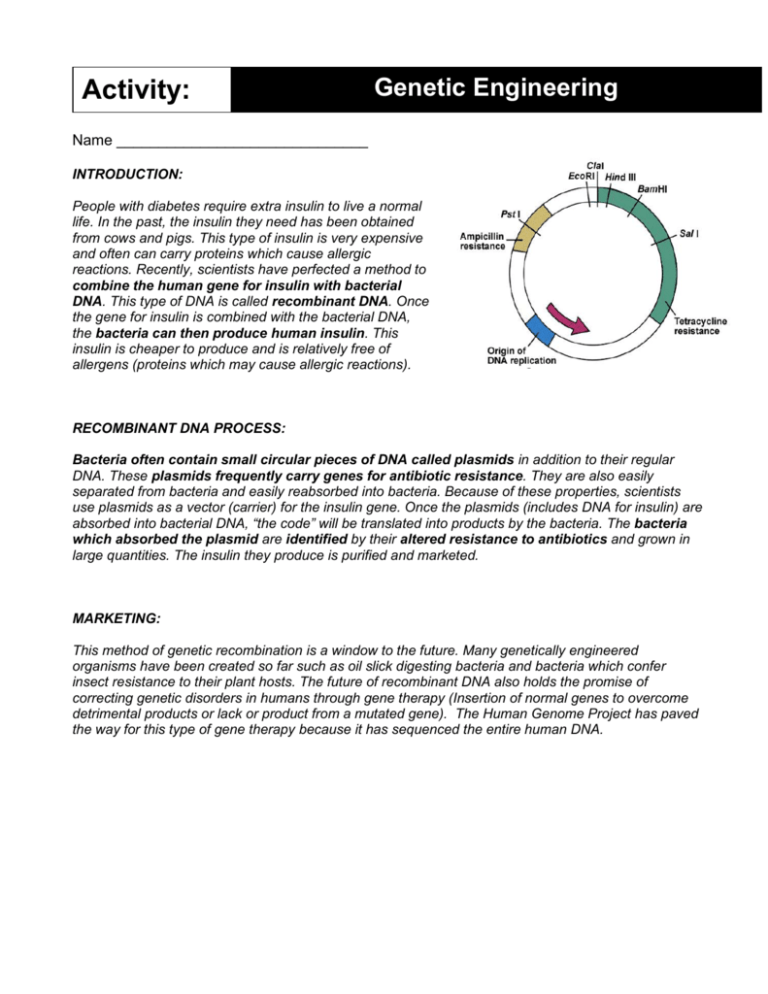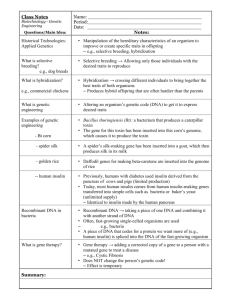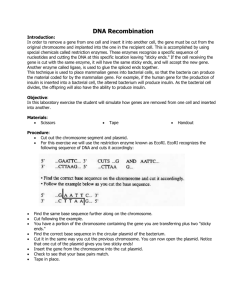Insulin Genetic Recombination Lab
advertisement

Activity: Genetic Engineering Name ______________________________ INTRODUCTION: People with diabetes require extra insulin to live a normal life. In the past, the insulin they need has been obtained from cows and pigs. This type of insulin is very expensive and often can carry proteins which cause allergic reactions. Recently, scientists have perfected a method to combine the human gene for insulin with bacterial DNA. This type of DNA is called recombinant DNA. Once the gene for insulin is combined with the bacterial DNA, the bacteria can then produce human insulin. This insulin is cheaper to produce and is relatively free of allergens (proteins which may cause allergic reactions). RECOMBINANT DNA PROCESS: Bacteria often contain small circular pieces of DNA called plasmids in addition to their regular DNA. These plasmids frequently carry genes for antibiotic resistance. They are also easily separated from bacteria and easily reabsorbed into bacteria. Because of these properties, scientists use plasmids as a vector (carrier) for the insulin gene. Once the plasmids (includes DNA for insulin) are absorbed into bacterial DNA, “the code” will be translated into products by the bacteria. The bacteria which absorbed the plasmid are identified by their altered resistance to antibiotics and grown in large quantities. The insulin they produce is purified and marketed. MARKETING: This method of genetic recombination is a window to the future. Many genetically engineered organisms have been created so far such as oil slick digesting bacteria and bacteria which confer insect resistance to their plant hosts. The future of recombinant DNA also holds the promise of correcting genetic disorders in humans through gene therapy (Insertion of normal genes to overcome detrimental products or lack or product from a mutated gene). The Human Genome Project has paved the way for this type of gene therapy because it has sequenced the entire human DNA. Purpose In this activity, you will construct a simple model of the process of genetic recombination (gene transfer) which demonstrates the insertion of an insulin gene into a bacterial plasmid. Materials Activity packet (including DNA sheet) Scissors Tape Colored Pencils Method 1. Color the gene for insulin, the gene for tetracycline resistance, and the gene for ampicillin resistance using different colors. These are the shaded portions of the DNA sequence page. Make a note of which color was used for which gene. Insulin gene: Tetracycline resistance: __________________ Ampicillin resistance: __________________ __________________ 2. Cut out the DNA strip for each type of DNA. Assemble the plasmid DNA (ampicillin strip) into a circle by taping the ends together. Leave the insulin gene flat. 3. Use the template below to draw a diagram of the circular plasmid DNA not including base pairs. Label the areas of antibiotic resistance using same colors as in step 1. 4. Restriction enzymes are used to cut DNA at specific, known points in the base pair sequence. These enzymes don't just chop the DNA molecule in half, they cut into one strand and then cut between base pairs before cutting through the other strand of the DNA molecule. This results in "sticky" ends on the cut edges of the DNA. The enzyme used to cut open the plasmid DNA is also used to cut out the insulin gene from a segment of human DNA. Look at the model of the restriction enzyme cut on the DNA sequence page. Notice the pattern that it cuts. 5. Cut your DNA at the base sequence that matches the restriction enzyme site. Be sure to cut exactly as shown on restriction enzyme model each time. You will need to make a cut on each side of the insulin gene and just one cut to open the plasmid. You should have "sticky" ends on both the plasmid and the human DNA. 6. Since the sticky ends are matched up between the insulin gene and the plasmid DNA, a ligase enzyme joins the pieces. Insert the insulin gene into the plasmid by matching up sticky ends and taping the pieces together. You now have recombinant DNA!! 7. Draw a diagram of new recombinant plasmid. Indicate insulin gene placement. Use the color scheme established in step 1. Activity: Genetic Engineering Name ______________________________ Analysis Questions 1. What two types of enzymes are required to make recombinant DNA? 2. You used scissors and tape in this lab. a. Which enzyme was represented by the action of the scissors to cut open plasmid and cut insulin gene from DNA strip? b. Which enzyme was represented by taping together the "sticky" ends? 3. Why do scientists use the same enzyme to remove the insulin AND cut the plasmid open? 4. When you cut the plasmid DNA with your "enzyme" did you cut into either of the gene for antibiotic resistance? If so, which one(s)? 5. Humans are very different from bacteria. Why do you think it is possible to combine their DNA and have bacteria successfully manufacture human protein? Ampicillin resistance gene Tetracycline resistance gene DNA Sequence T A C T T G G A T G A T C C A C T G PLASMID Human Insulin Gene A T G A A C C T A C T A G G T G A C HUMAN DNA INSULIN GENE G C T T G G G T A G C G T T G G C A RESTRICTION ENZYMES cut along the solid line anywhere the sequence is found (either direction) C G A A C C C A T C G C A A C C G T T A T A G C G C







